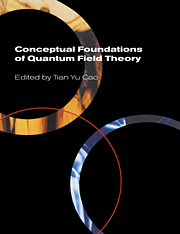Book contents
- Frontmatter
- Contents
- List of contributors
- Preface
- Photographs of the conference
- Introduction: Conceptual issues in quantum field theory
- Part One Philosophers' interest in quantum field theory
- Part Two Three approaches to the foundations of quantum field theory
- Part Three
- Part Four Mathematics, statistics and quantum field theory
- 8 Renormalization group theory: its basis and formulation in statistical physics
- 9 Where does quantum field theory fit into the big picture?
- 10 The unreasonable effectiveness of quantum field theory
- 11 Comments: The quantum field theory of physics and of mathematics
- Part Five Quantum field theory and space-time
- Part Six
- Part Seven Renormalization group
- Part Eight Non-Abelian gauge theory
- Part Nine The ontology of particles or fields
- Part Ten
- Name index
- Subject index
10 - The unreasonable effectiveness of quantum field theory
Published online by Cambridge University Press: 22 September 2009
- Frontmatter
- Contents
- List of contributors
- Preface
- Photographs of the conference
- Introduction: Conceptual issues in quantum field theory
- Part One Philosophers' interest in quantum field theory
- Part Two Three approaches to the foundations of quantum field theory
- Part Three
- Part Four Mathematics, statistics and quantum field theory
- 8 Renormalization group theory: its basis and formulation in statistical physics
- 9 Where does quantum field theory fit into the big picture?
- 10 The unreasonable effectiveness of quantum field theory
- 11 Comments: The quantum field theory of physics and of mathematics
- Part Five Quantum field theory and space-time
- Part Six
- Part Seven Renormalization group
- Part Eight Non-Abelian gauge theory
- Part Nine The ontology of particles or fields
- Part Ten
- Name index
- Subject index
Summary
Quantum field theory offers physicists a tremendously wide range of application: it is a language with which a vast variety of physical processes can be discussed and also provides a model for fundamental physics, the so-called ‘standard model’, which thus far has passed every experimental test. No other framework exists in which one can calculate so many phenomena with such ease and accuracy. Nevertheless, today some physicists have doubts about quantum field theory, and here I want to examine these reservations. So let me first review the successes.
Field theory has been applied over a remarkably broad energy range and whenever detailed calculations are feasible and justified, numerical agreement with experiment extends to many significant figures. Arising from a mathematical account of the propagation of fluids (both ‘ponderable’ and ‘imponderable’), field theory emerged over a hundred years ago in the description within classical physics of electromagnetism and gravity. [1] Thus its first use was at macroscopic energies and distances, with notable successes in explaining pre-existing data (relationship between electricity and magnetism, planetary perihelion precession) and predicting new effects (electromagnetic waves, gravitational bending of light). Schrödinger's wave mechanics became a bridge between classical and quantum field theory: the quantum mechanical wave function is also a local field, which when ‘second’ quantized gives rise to a true quantum field theory, albeit a non-relativistic one. This theory for atomic and chemical processes works phenomenally well at electron-volt energy scales or at distances of O(10−5 cm).
- Type
- Chapter
- Information
- Conceptual Foundations of Quantum Field Theory , pp. 148 - 160Publisher: Cambridge University PressPrint publication year: 1999
- 2
- Cited by



